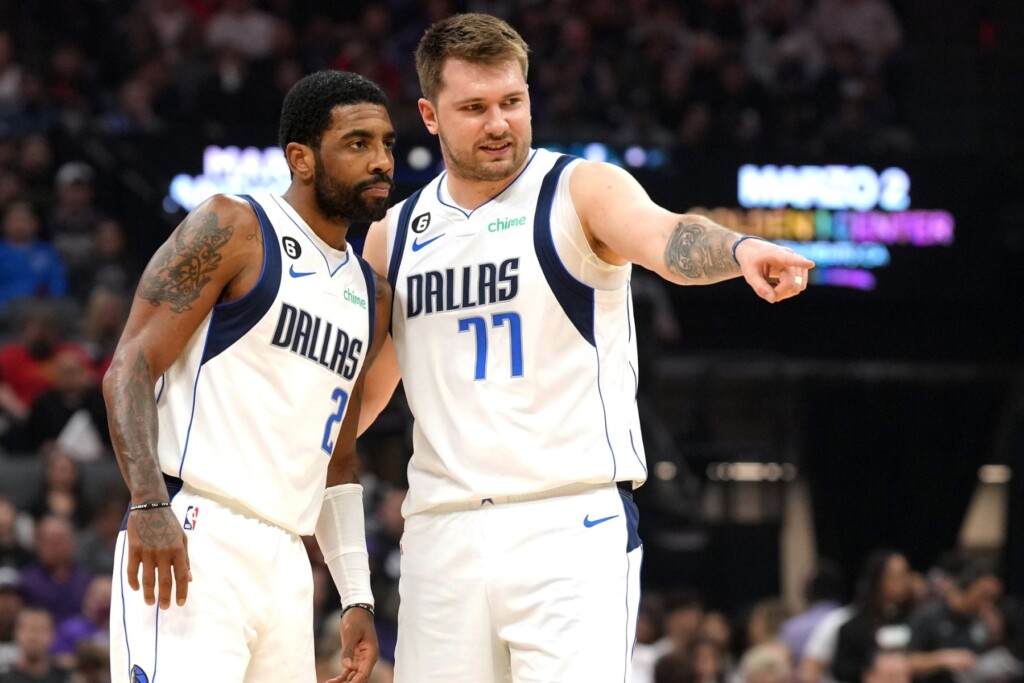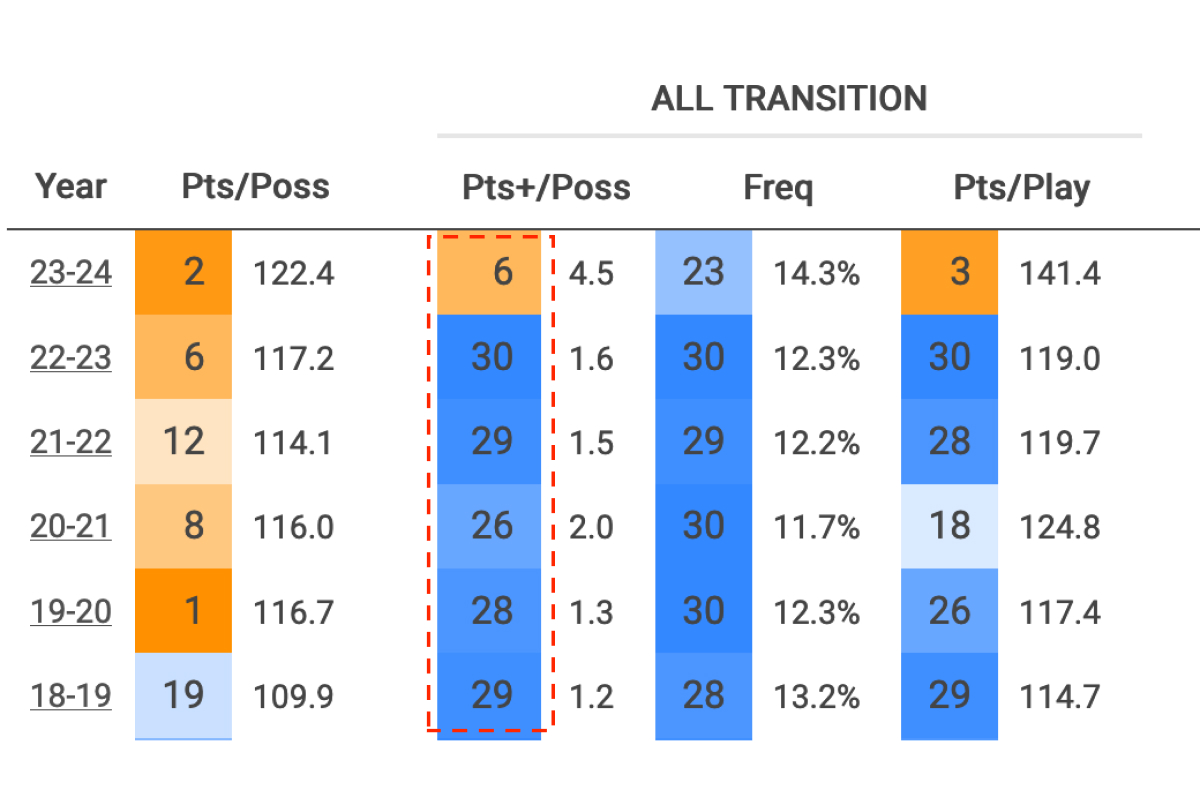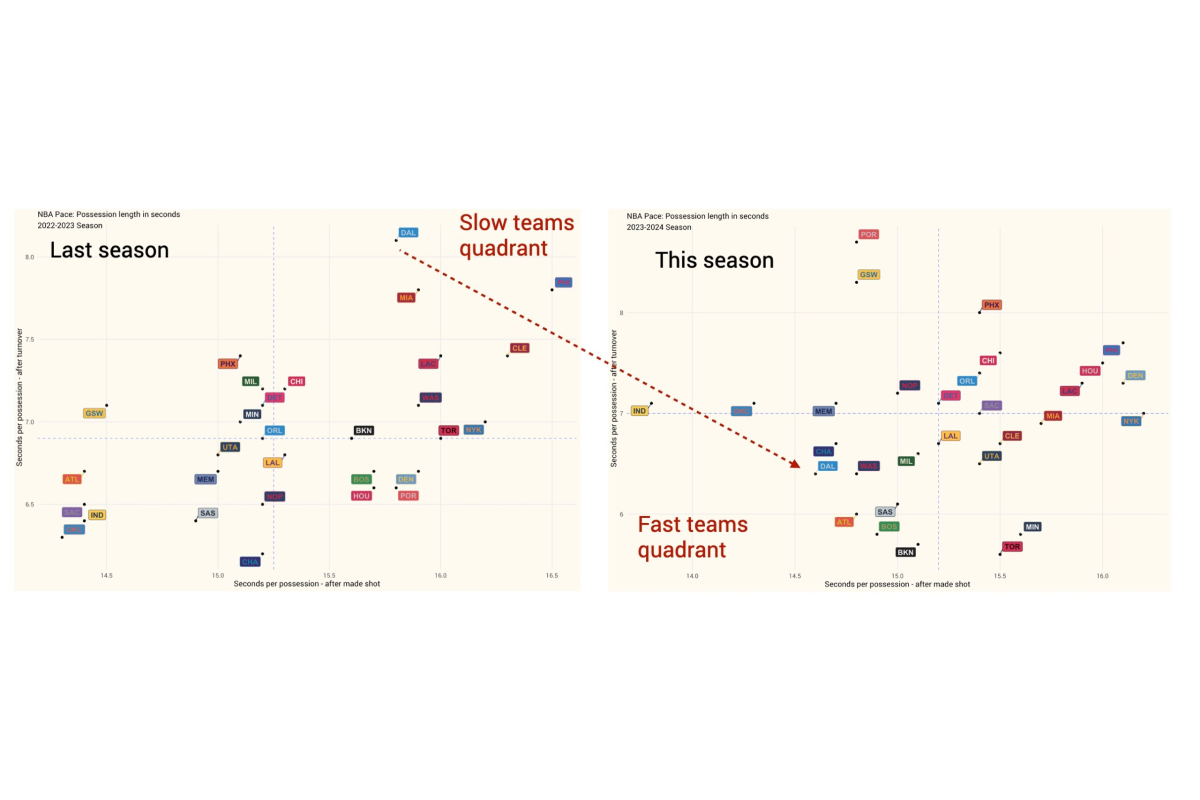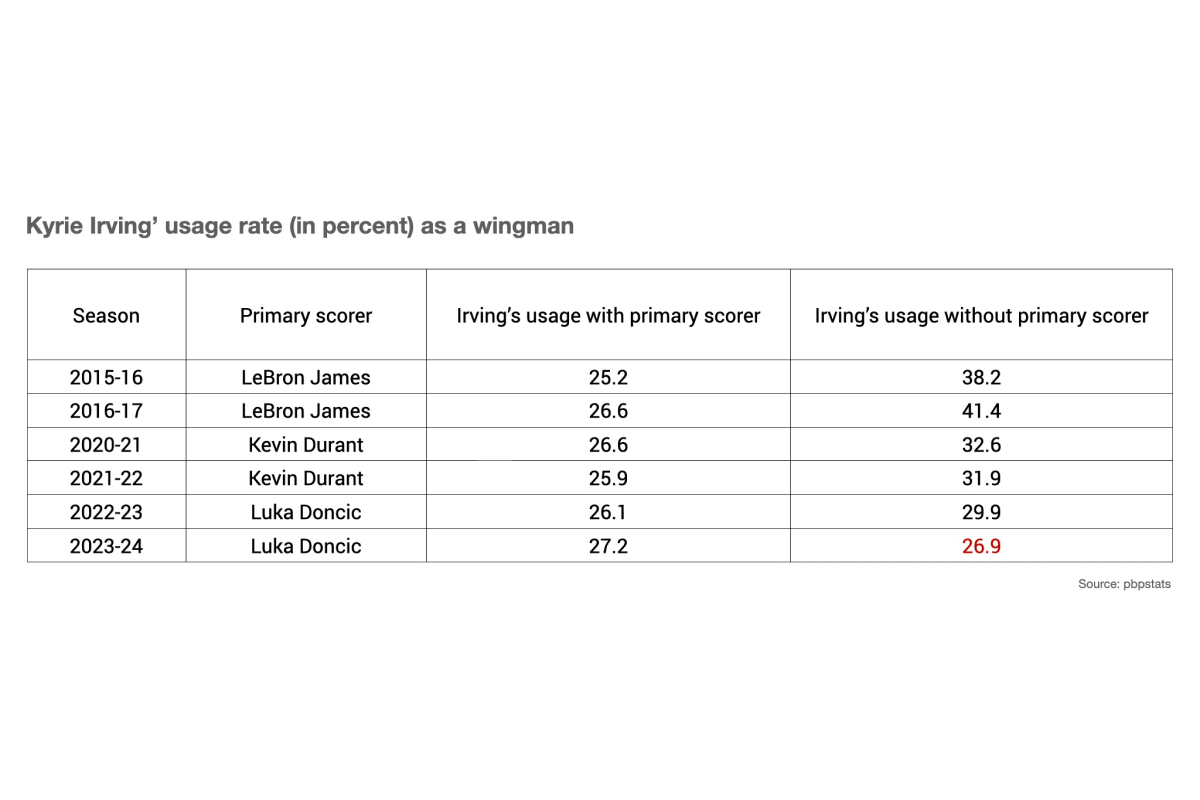“When you’re winning everything is great.” —Luka Doncic in New Orleans on November 13, 2023
I don’t want to contradict anything Doncic does or says, but great might be an understatement.
The Mavericks are 8-2, tied with the Denver Nuggets for the top spot in the Western Conference. According to Cleaning the Glass, they have the NBA’s best offense, along with the Rick Carlisle–led Indiana Pacers.
Just a month ago, things didn’t appear as promising. The Mavericks were returning from their final stop on what is believed to be the NBA’s longest preseason trip ever, which included a stop for Doncic’s homecoming in Madrid. They appeared banged up, with both of their superstars missing the final portion of the overseas games while nursing nagging injuries.
So, how did we get here, with the Mavericks running out of the gates and steamrolling through their first 10 games?
And yes, when I say running, I do mean running. Many aspects of the Mavericks’ performance have improved this season compared to where they left off last April, as we’ll explore shortly. But while most of these improvements weren’t difficult to predict, one aspect caught me completely off guard. If you had told me before the season that the Mavericks would start 8-2 and be ranked sixth in transition efficiency, I could have believed the former, but I would have had a hard time believing the latter. The Mavericks, after all, were cellar dwellers in transition efficiency in each of the Doncic’s first five seasons, including dead last a season ago.
It took two years and one significant end-of-season disappointment for Jason Kidd to finally put his imprint on the offense and, more important, to persuade his quarterback to play at a faster pace. And it’s not just running in transition: the Mavericks rank ninth in the NBA in overall pace and operate at a much faster tempo in all aspects of their offense, whether it’s pushing the pace off a turnover or attempting to initiate early offense after an opponent’s made basket.
The Mavericks have been the best half-court offense over the last five seasons (they rank first at the moment as well), so supercharging that with easy buckets in transition helps explain their leap from the sixth-ranked overall offense last year to top of the league in 2023-24.
The Mavericks started with a bang, winning their first four games. Doncic set the pace with a trio of MVP-like performances, averaging 39 points, 12 rebounds, and 10 assists in three October games. He came through in the clutch in each of those games, including a one-handed off-balance dagger against Brooklyn. Doncic is in arguably the best shape of his career, and seeing the 24-year-old Slovenian superstar buying in on playing faster, participating on defense, and cutting down on the complaints to the referees is a great sign that the Mavericks are ready to reclaim their spot in the upper echelon of the Western Conference. Doncic, meanwhile, has established himself as the early frontrunner in the MVP race. He is the league’s leading scorer at 32.6 points per game, and he is doing it at a career-best level of efficiency. The major reason for the latter is he’s hitting on 42 percent of his three-point shots.
While we’ve seen a fair share of similar dominant stretches from Doncic over the last couple of years, there are other positive signs that his partnership with Kyrie Irving is moving in the right direction after a rocky start last February. Doncic’s 34 percent usage rate (the lowest since his rookie season) and the fact that 20 percent of his shots are assisted (the highest since his rookie season) are indicators that he is willing to embrace his co-pilot and is carrying a lesser load than in prior years. The Mavericks need both if they expect to sustain their success.
Speaking of Irving, he’s hitting his stride after a slower than expected start to the season. While Doncic’s efficiency is at a career-high rate, his 31-year-old backcourt mate’s is at its lowest point since the 2015-16 season. Irving openly talked about taking extended time off during the summer, and as a result, he is not starting the season in optimal game shape. He is averaging 23 points per game, a four-point drop from last season’s mark with the Mavericks. He missed two games early in the season and has struggled with his shooting, posting only a 24 percent three-point shooting rate in his first five games.
Irving appeared passive, and while many fans speculated he was deferring to Doncic too much, he was, in fact, taking a back seat to Tim Hardaway Jr. in minutes when Doncic was off the floor. Irving’s usage rate is lower with Doncic off the floor, while Hardaway’s usage rate has skyrocketed to 31.7 percent in those situations.
The good news for the Mavericks is that it seems Irving didn’t need long to get back on track. He is averaging 28 points over the last three games and is often the one throwing the first punch. He scored 20 points in the first half of a blowout win against the Clippers last Friday and had 22 before the break against the Pelicans on Sunday. His three-point percentage has returned to its customary 40 percent after a recent hot shooting stretch, but his at-the-rim percentage still sits at only 59 percent for the season—another sign that he hasn’t fully regained the lift in his legs. Recent games showed that when Doncic and Irving are at the top of their games, the offense becomes almost unstoppable.
That said, last season’s collapse was proof that the Mavericks couldn’t do it relying solely on their two superstars. To climb in the standings they first had to overhaul the roster. Their summer moves showed there was a deliberate change of course toward a younger, more athletic, longer, and defensive-minded supporting cast. The three new starters—Grant Williams, Dereck Lively II, and Derrick Jones Jr.—fit that bill, so even while the latter two starting was a surprise, it made sense when looking at the situation through those lenses. Based on on/off numbers, the three are the best defenders on the team, and they form the backbone of a new-look defense. It remains a work in progress, as Dallas ranks 23rd in defensive rating, the same position it finished in last year. In the 213 possessions when those three players have shared the floor, however, the Mavericks are allowing only 108.1 points per 100 possessions.
Lively, the lottery-pick rookie, has been way ahead of the curve, averaging 9 points, 7 rebounds and one block per game. He already had three double-digit scoring and rebounding games, showing glimpses of what to expect. The 7-foot-1 pogo stick has had his ups and downs, which is reasonable to expect for a 19-year-old playing the most important defensive position on the floor. Lively is averaging 5.6 fouls per 36 minutes, which has limited his playing time, but the good news is that the Mavericks can turn to the evergreen Dwight Powell when needed. He’s playing better minutes, contributing with his hustle as a backup rather than being overwhelmed as a starter.
Williams is another offseason addition who has surpassed all expectations. The sturdy 6-foot-6 forward is averaging career highs in points per game (11.4), three-point attempts (5.4), and three-point accuracy (50 percent). His willingness to take and ability to make the three—alongside Doncic, Irving, and Hardaway—is a significant factor contributing to the Mavericks’ rank as the NBA’s top shooting team. (They lead the league in three-point frequency and accuracy.)
Jones was a surprise starter to many, but despite not having the profile of a high draft pick or a marquee free-agent signing, he represents the type of smart, under-the-radar addition the Mavericks have needed for quite some time. The team needed a long and athletic wing defender who could apply pressure and navigate screens in pick-and-roll situations, particularly because it predominantly employs conservative drop and ice coverages with its centers positioned well below the screen. Jones has solidified his position as the team’s most effective point-of-attack defender, whether assessed by pick-defense data or the eye test. (Josh Green still lacks the discipline required to assume the role of the primary on-ball defender, but he thrives in more chaotic situations, where his speed and energy can create havoc.)
The challenge with Jones has always been his shooting; opponents will continue to single him out as the weakest option on the floor. The athletic 6-foot-5 Jones is averaging 4.1 three-point attempts per game, a significant increase from his career average of 1.6, and more than double his usual rate when calculated on a per-36-minutes basis. His 37 percent shooting from beyond the three-point line is perhaps the most significant statistic among all of the Mavericks’ impressive shooting numbers. For the team to have any hope of improving its struggling defense, Jones needs to be a playable option. That’s largely because his impact on defense, as reflected in the on/off data, has been the most significant on the team. The thing to watch is his corner three: he will need to improve upon his 27 percent shooting rate from those spots, especially because he takes the most shots from that part of the floor on the team.
The key issue for the Mavericks on the defensive end continues to be a lack of size. They allow the fourth-most points in the paint, have the second-worst opponent field goal percentage at the rim, and still rank as one of the worst rebounding teams in the league. Kidd has opted for his largest lineup in the starting five with Doncic, Lively, Williams, and Jones, but things have fallen apart when subs check in. Maxi Kleber’s struggles have left Powell as the sole rotation player taller than 6-foot-5 off the bench, and even he is an undersized center. This has meant a lot of three- and even four-guard lineups that are potent offensively, but struggle to defend and get crushed on the glass. Both of the Mavericks’ losses occurred because they got bullied in the paint and on the boards by the bigger and stronger Nuggets and Raptors.
The Mavericks have faced a relatively soft slate, ranking fifth in terms of ease of schedule. The real tests against some of the bigger teams—including games against the Lakers, Bucks, Timberwolves, and Nuggets—are coming up in the next month. We’ve witnessed a more athletic team with a significantly higher floor than last year’s version of the Mavericks, but one that still has similar limitations. Last season’s version of the Sacramento Kings serves as a valuable reminder for both, which is not a bad thing considering where the Mavericks were last April. To get more out of this team, the front office will have to get creative again and balance some of the scoring logjam in the backcourt with more size and defensive prowess on the wing. So while nobody can complain about the start, the Mavericks remain a work in progress.
Author










